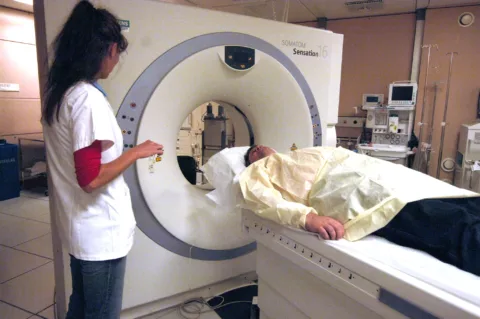If you’ve never had a CT scan before, then you’re probably wondering what’s a CT scan like? And how is a CT scan (or CAT scan) different from an MRI?
I recently had my first CT scan (Computed Tomography scan) after my primary physician believed he felt something unusual near my thyroid during a checkup.
I was asymptomatic and hadn’t noticed any lump on my throat, but we don’t always see things about ourselves that others may notice. My doctor said he didn’t think I had a nodule, but he felt some “thickening” near the right side of my thyroid that needed to be checked out.
Doc ordered a CT scan to get a better picture of this thickening that he didn’t think a basic ultrasound would pick up on.
I agreed. But I had never had a CAT scan before. I wondered:
- What’s a CT scan like?
- Is the radiation from a CAT scan safe?
- What does the CT scan prep consist of?
- Does it hurt getting a CT scan?
- What’s it like getting a CAT scan with contrast?
Here’s what I’ve learned after having my first CT scan…
What It’s Like Getting A CAT Scan
The biggest difference between an MRI and CT scan is the fact that MRIs use radio waves and CT scans use x-rays.
See when doctors typically order a CT scan vs. MRI and 13 things you should know before your first MRI.
While having a CT scan is a relatively simple procedure, the scan itself can provide a multitude of answers for a variety of health issues.
In my case, the doctor wanted to confirm if there was a lump in my neck. And, if there was… whether it was benign or cancerous.
Going into the procedure was easy enough. And the attending radiologist made the scan relatively easy for me.
After I checked in, I was called back to the CT scanning room.
The radiologist made sure that I had no metal on me. So, I had to leave my cell phone, keys, wallet, and sunglasses with a friend who accompanied me to my appointment. I was able to leave my clothes and shoes on.
What the CAT scan machine is like
I was then directed to lay down on the table. The CT scanner used for my scans was an open device that looked much like the one pictured above. However, other CAT scan machines are bigger contraptions that automatically move you into a long, narrow tunnel.
The radiologist gave me a firm foam pillow to rest my head on. She also had me leave my hands and arms to my side.
Then, she injected a needle into the crook of my right arm. (That needle would later be used inject an iodine contrast dye that would help my thyroid and other parts inside my neck show up better on the scan. But she didn’t actually inject the iodine yet.)
Once the injection was done, she warned me that I would need to hold my breath, not swallow, and lay still at certain points during my scan.
Then, she went into an adjoining room. A big window separated the CT scanning room from the control center where the radiologist sat. From inside the radiation-safe room, she began the scan.
The table slowly moved me backward, head first, into the circular opening of the CT scanner. It moved me into the machine’s opening to where my throat was directly under the scanner itself.
The noise from the machine sounded like a loud whirring — but it wasn’t so noisy that it was uncomfortable to my ears or anything.
After a moment, I heard a voice come through a small speaker at the top of the CAT scan machine that instructed me to hold my breath, not to swallow, and to hold still. I managed to do this the first time without a problem — staying still for about 15 seconds.
Then came a point where I had to hold my breath again.
Oops… I made a mistake!
This time I wasn’t prepared, and I ended up swallowing by accident during this portion of the exam.
The radiologist had to stop the scanner. She came out of the room and explained how critical it is to lay still during this part of the procedure.
Of course, I understood — but told her I had an issue with a gag reflex at that moment and was in extreme discomfort. She understood and told me she could count down over the speaker to the moment I had to hold still.
She proceeded back to the room overlooking the CAT scanner and began the exam again. This time, she counted down from “5” to the point where I had to lay still and not swallow. She then gave me some verbal cues during this point of the exam, regarding how much longer I had to stay still. (The verbal coaxing helped quite a bit!)
Another minute or so passed by and then the CT scan machine stopped. The radiologist came out and told me it was time for the iodine contrast part of the exam. She said that I’d probably feel a warm feeling overtake my body, beginning at the back of my throat and radiating downward into my arms and legs.
What the contrast feels like
She injected the iodine, and boy was she right — a weird warmth flushed down my throat and I immediately noticed a metallic taste in my mouth.
Within a couple seconds, the warm sensation permeated into my upper arms… and then into my hands.
Next, I felt this sensation trickle into my thighs and then feet.
The feeling didn’t last long — it seemed to dissipate after a few moments.
The radiologist warned me that I had just one chance to get this next part of the exam done correctly. She said that I must hold still when instructed — so the scan could pick up everything clearly.
The radiologist went back into the room and she continued the scan. As with the previous part of the CT scan, she instructed me over the speaker when to hold my breath. She talked me through this part of the exam. Like last time, this part of the CAT scan lasted about 15 seconds.
The table moved me out of the tunnel, and then the machine was turned off. The radiologist walked out from the windowed room again and told me the CAT scan was done. She removed the iodine injection needle and taped the entry wound up with cotton. As she wrapped up my arm with a bandage, she told me I should drink lots of water that day to flush out the iodine contrast dye from my system.
Next, I was told I could get up from the table and leave. She led me out of the CT scan exam room, and then I walked out to meet my friend.
In all, my CT scan took just 10 minutes to complete. The average CT scan takes anywhere from 10 to 20 minutes to finish — although some take longer.
Waiting for the results
The scan was over, but now the hard part began… Waiting for the results!
Perhaps the worst thing about my CT scan was the anxiety (or scanxiety) — waiting to find out if I had to face a cancer diagnosis.
Within 36 hours, I received a called from my doctor’s office. Thankfully, my CAT scan showed no masses, no lumps… and no cancer!
What Does CT Scan Prep Consist Of?
So, how do you prepare for a CT scan?
That’s something only your doctor or a medical professional handling your CAT scan appointment can tell you — because scans sometimes require different prep procedures.
In general:
- If your CT scan is to be taken with contrast, you won’t be able to eat for 3 to 4 hours prior to your exam.
- If there’s no contrast involved, you’re normally able to eat and drink as well as take medications up to the point prior to your CAT scan.
In my case, I wasn’t able to eat or drink anything for 4 hours prior to my CT scan with contrast.
Again, it’s best to double check with a medical professional before beginning preparations for your CAT scan.
Does It Hurt Getting A CT Scan?
No! The CT scan itself didn’t hurt at all. Even the contrast circulating through my body didn’t hurt.
However, the injection the radiologist used for the contract did pinch a bit — just like it does when donating blood.
She left the needle in my arm for the duration of the scan, but the worst part was just the initial pinch of getting the injection done.
After a few moments, this minor injection pain almost completely subsided and I all but forgot the needle was in my arm.
Is The Radiation From A CAT Scan Safe?
You know, I really wasn’t nervous about getting the CT scan itself. What worried me more were the potential longterm effects of the CAT scan.
A CT scan spews out many times more radiation than a typical X-ray… and the verdict is still out on exactly how safe getting a CT is.
Yes, CT scans definitely have benefits — they can provide far better resolution than X-rays and are often required if an X-ray or ultrasound show a suspicious lump.
But a CT scan pumps out so much radiation that getting even one may increase your risk of getting cancer. The chances of getting a cancer from a single CT scan is about 1 in 1,000. The more you get, the higher your risk of getting cancer from CAT scans.
In many cases, it comes down to weighing the risks versus the benefits. Obviously, the radiation from getting a CT scan is not good for your body — but getting these scans is essential to diagnosing cancer, tracking tumors, and monitoring other potentially deadly maladies. CT scans also help determine whether you might need surgery to remove or fix other types of health issues.
And keep this in mind… The average man or woman has about a 1 in 3 chance of developing cancer and a 1 in 5 chance of dying from cancer.
So yes, getting a CT scan can enhance your risk of developing cancer. But having a CT scan done doesn’t guarantee you will get cancer. And your overall chances of getting cancer are already much higher anyway than the increased risk you may face from getting a few CT scans.
At the end of the day, only you and your doctor can determine what the right choice is concerning whether or not you should get a CT scan.
Here are some frequently asked questions about having a CAT scan with contrast.
I want everyone to live their best life… for as long as possible. So I often write about the health screenings that we all should be getting — to help catch potential health issues early. (Yes, I get my screenings too.) I also share my knowledge and experience with specific health problems that I am personally familiar with.






